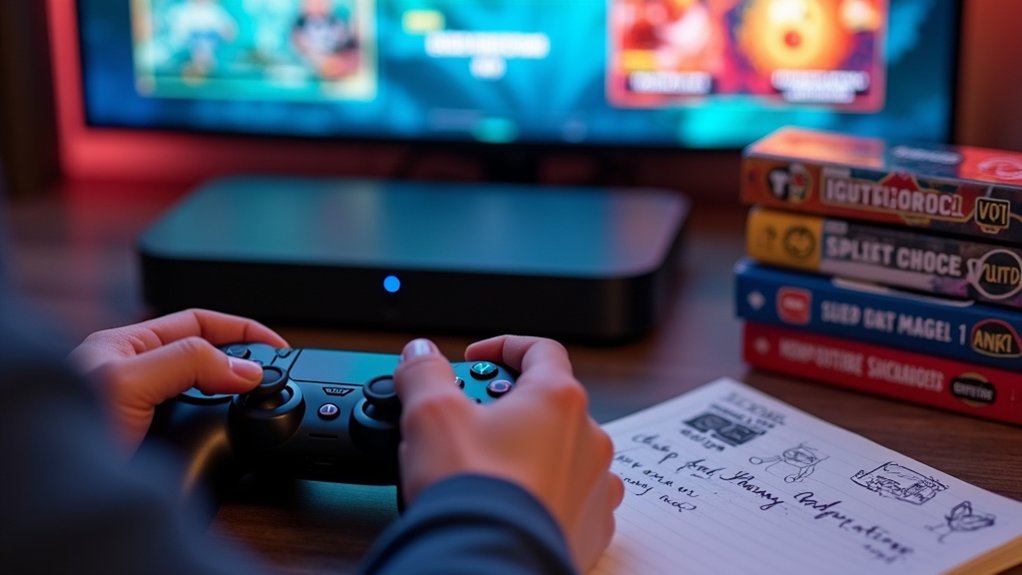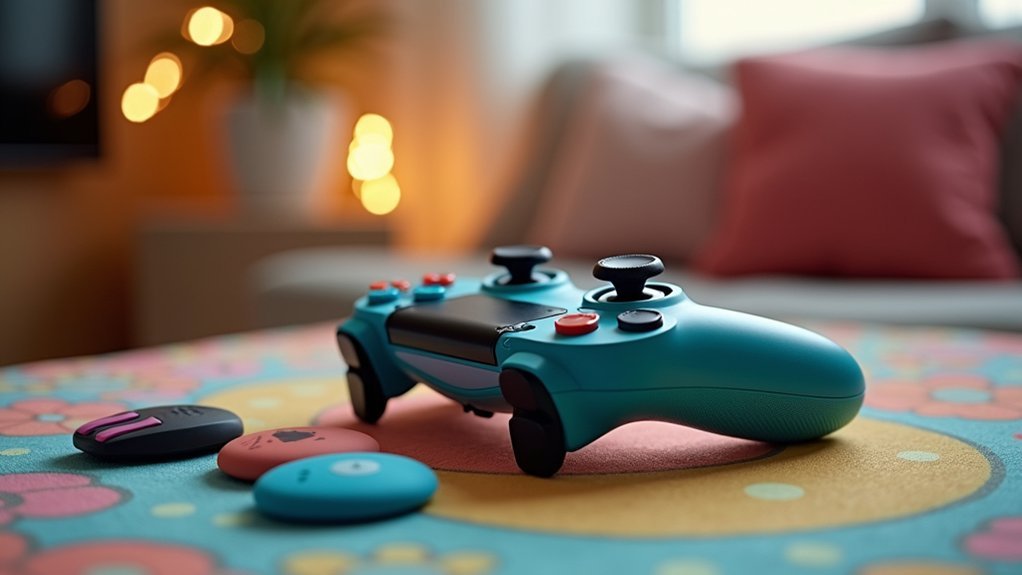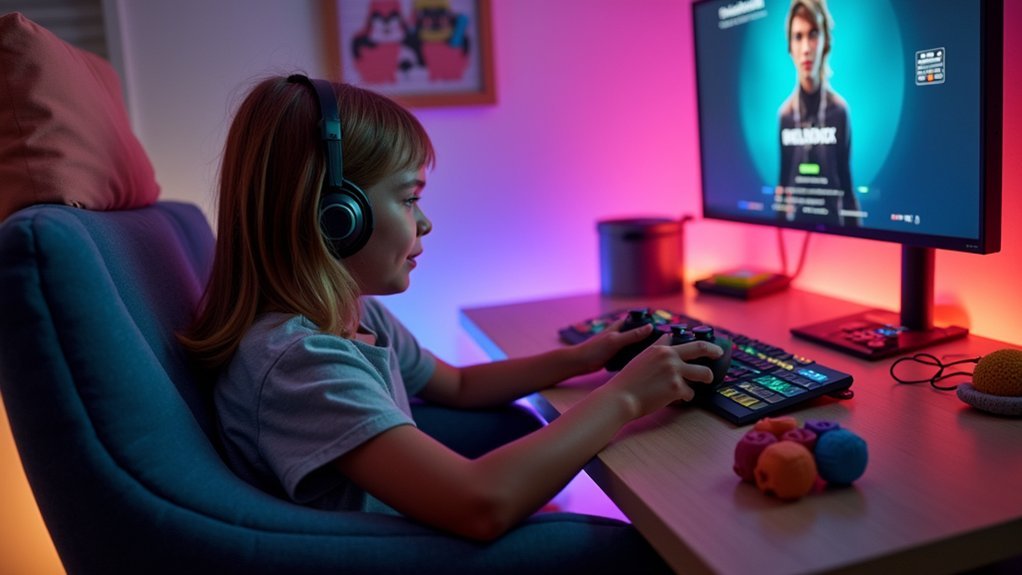For cognitive disability-friendly gaming, look for titles with adjustable difficulty settings like Celeste’s Assist Mode. Customize visual elements by increasing text size, enabling subtitles, and reducing visual clutter. Adjust audio settings to emphasize important gameplay cues while minimizing distracting background noise. Consider adaptive controllers with programmable buttons for simplified control schemes. These adjustments can transform gaming from frustrating to enjoyable—discover how these personalized accommodations can enhance your gaming experience.
Choosing Games With Adjustable Difficulty Settings

When selecting games for players with cognitive disabilities, adjustable difficulty settings stand out as perhaps the most essential feature to take into account.
Adjustable difficulty settings empower players with cognitive disabilities to customize their gaming experience according to individual needs and abilities.
Look for titles offering multiple preset modes that can be changed during gameplay, not just at the beginning.
Games like Celeste with its Assist Mode or The Last of Us Part II with over 60 accessibility options provide excellent examples of inclusive design.
These games allow you to adjust speed, complexity, and even offer invincibility options when needed.
The best implementations include clear descriptions of what each setting changes, gradual difficulty increments, and the ability to customize specific challenges independently.
Remember that games with dynamic difficulty scaling can automatically adapt to your performance, reducing frustration and extending enjoyable playtime.
Many game developers now incorporate simplified user interfaces as part of their cognitive accessibility offerings, making game navigation less overwhelming.
Customizing Visual and Audio Elements for Better Comprehension
Adjustable difficulty settings work best when paired with customizable visual and audio elements that support players with cognitive disabilities.
You’ll find that adjusting these settings can dramatically improve your gaming experience by reducing cognitive load and enhancing information processing.
- Increase text size and contrast for easier reading of instructions and dialogue
- Activate subtitles and simplified language options to better understand game narratives
- Reduce visual clutter by turning off non-essential effects and animations
- Adjust audio levels to highlight important gameplay cues while minimizing distractions
- Use pause features to take breaks when needed, allowing you to process information at your own pace
Many games now include dedicated accessibility menus where you can find these options, often categorized by sensory need. Interactive tutorials that allow you to learn gameplay mechanics through hands-on practice rather than text instructions can significantly benefit those with cognitive disabilities.
Setting Up Adaptive Controllers for Simplified Play

Adaptive controllers offer a transformative gateway to gaming for players with cognitive disabilities, simplifying complex control schemes into manageable interactions.
The Xbox Adaptive Controller and PS5’s Access Controller feature large, programmable buttons that you can customize to match your specific needs.
Consider integrating voice control software to further reduce physical demands while playing. For a truly personalized setup, connect external devices like sip-and-puff switches or adaptive switches that enable control through alternative body movements.
When setting up your controller, take advantage of programmable buttons by assigning complex functions to accessible inputs. Regular calibration guarantees peak performance, while software updates maintain compatibility with new games.
If you encounter difficulties, reach out to resources like AbleGamers or assistive technology labs for support and guidance.
Frequently Asked Questions
How Can I Find Gaming Communities Specifically for Cognitive Disability Players?
You’ll find specific gaming communities through AbleGamers forums, Reddit’s disability gaming groups, specialized Discord servers, social media hashtags like #AccessibleGaming, and by joining Player Panels that connect disabled gamers with developers.
What Mobile Games Are Most Accessible for Cognitive Disabilities?
You’ll find Pokémon GO, Minecraft, and Monument Valley highly accessible for cognitive disabilities. They offer adjustable difficulty, clear instructions, intuitive controls, and relaxed gameplay. Many also include helpful visual and audio cues.
How Long Should Gaming Sessions Last to Prevent Cognitive Fatigue?
You should limit your gaming sessions to under two hours to prevent cognitive fatigue. Take regular breaks, as your performance decreases even when you’re not aware of it. Your pupil size indicates mental exhaustion.
Can Multiplayer Games Be Accessible for Players With Cognitive Disabilities?
Yes, multiplayer games can be accessible for you with cognitive disabilities. You’ll benefit from games with customizable difficulty, clear instructions, adjustable pacing, and multiplayer modes that accommodate different skill levels.
Are There Specific Genres Best Suited for Cognitive Disability Players?
Puzzle, educational, and certain action games suit you best. You’ll benefit from games with adjustable difficulty, clear objectives, and customizable controls. Choose genres matching your specific cognitive needs and interests.
In Summary
You’ve now got three powerful tools to make gaming more accessible with your cognitive disability. By choosing games with adjustable difficulties, customizing visual and audio settings to match your needs, and setting up adaptive controllers, you’ll create a gaming experience that works for you. Remember, gaming should be fun, not frustrating—don’t hesitate to adapt your setup until it feels just right.





Leave a Reply